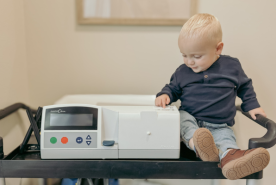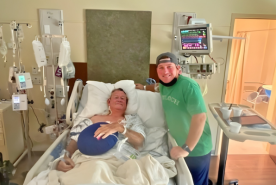Last updated: April 03, 2024
Medically reviewed by: NKF Patient Education Team
The transplant waitlist matches deceased donors with kidney patients for a transplant. How long it takes to get one depends many factors, but it can take 2-5 years or more.
About the transplant waitlist
The goal of the transplant system is to find the right kidney at the right time for the right person. Finding the right match depends on several factors and can sometimes take a long time.
The transplant waitlist, managed by the OPTN, is a list of all the people in the United States who are waiting for an organ transplant, including kidneys. The waitlist is only for organs from deceased donors. Deceased donors are people who donate organs at the time of their death. When a deceased donor kidney is available, the system makes a list of “matches” with people on the waitlist. Where you are on that list depends on how well you match the donor kidney, how long you have been waiting, and more.
Once you are on the waitlist, you could receive a kidney from any organ donor, as long as you are a good match. Keep talking to your transplant center about your needs as you wait since your health and goals may change. It is important to stay as healthy as you can so you are ready for surgery when the time comes.
How long does it take to get a kidney transplant?
Once you are on the transplant waiting list, you may get called for a deceased donor kidney fairly quickly, or you may wait many years. In general, the average time is 3-5 years at most centers, but it can be longer in some parts of the country. You can talk to your transplant team about their list and how your specific situation will affect your wait time. Waiting times depend on several things, such as:
- How long you have been on dialysis or on the transplant waitlist
- The longer you wait, the higher you will be on the list for a kidney that matches you. Many people don’t know that the time you’ve spent on dialysis is also factored into how long you’ll wait for a kidney: the longer you are on dialysis, the higher up you’ll be on the list.
- Blood type
- Some blood types are more or less common. If you have a rare blood type that is hard to match, it can take longer to get matched with a deceased donor kidney.
- Where you live
- The geographical distance between where the donor is and where you live matters. Some parts of the country have more donors (shorter wait times). Other areas have more people on the waitlist (longer wait times).
- Your antibody levels
- More antibodies make it more likely that your body’s immune system will attack the new kidney. If you’ve been pregnant before, have had blood transfusions, or have already had a transplant, chances are you have a high antibody level.
You can be on the waitlist at more than one transplant center to increase your chances of getting a kidney more quickly. This is called multi-listing. Most transplant centers will allow you to transfer your lab work and imaging, like x-rays and CT scans from another center, but you’ll still have to meet with the new transplant center’s team for an in-person evaluation.
Another way to get a transplant sooner is to have a living donor kidney transplant. You won’t have to wait years for a kidney and you can schedule your surgery when it’s a good time for you and your donor.
You can get a better understanding of what your wait time might be at different centers by sharing specific information about yourself with this helpful tool.
What types of kidneys are available?
During your evaluation appointments, the transplant team will talk to you about the different types of kidneys that you can get. It’s important to get the best kidney that is right for you.
Each kidney from a deceased donor is different. The transplant center runs many tests on kidneys and always makes sure that every kidney is healthy and safe for transplantation.
To make the best match, all donated kidneys are given a KDPI score that shows how long the kidney is expected to work, based on things like the donor’s age, weight, and health history. A lower score means the kidney is expected to last longer. Patients who are younger and have spent a short amount of time on dialysis would most likely choose to get a low KDPI kidney, so it lasts as long as possible. However, high KDPI kidneys have proven to be very successful, especially for older people who have been on dialysis for a while or have been waiting a long time for a transplant. Getting a high KDPI kidney can help patients get a transplant sooner and provide freedom from having to stay on dialysis.
To learn more about high KDPI kidneys, visit the Underutilized Kidneys page.
Staying healthy while waiting for a kidney
Once you’re approved for the waitlist, it’s very important to stay healthy while you wait for a new kidney. Most centers will have you come for follow-up appointments each year that you’re on the waitlist. These appointments will make sure you’re staying healthy enough for the transplant surgery and have the best chance of living well with a new kidney. Some things to help you stay healthy are:
- Making sure you go to your scheduled doctor appointments, including dialysis
- Eating a healthy, kidney-friendly diet
- Taking your medications on time
If your transplant team decides that there is something that will keep you from being healthy enough for a transplant, they’ll place you as inactive on the waitlist. You’ll still be on the waitlist and gain time; you just won’t be called for a kidney if one becomes available for you. Once you’re healthy enough, you’ll be placed as active again. For example, if you have an infection, the transplant center would make you inactive until the infection is gone, then make you active again so you can be ready for a kidney.
When a kidney is ready for you
When a person who is on the waitlist, also called a recipient, is a good possible match for a kidney, the system lets their transplant center know that a kidney is available, called an “offer”. The transplant center can decide if they think the kidney is a good fit, and then the recipient is called to come in for surgery.
Once you’re approved for the waitlist, it's important that you have a working phone so the transplant center can reach you when a kidney becomes available for you. The transplant team could call you about an offer at any time, day or night, so always be prepared and have your phone on and nearby. They’ll let you know when it’s time to come into the hospital and run final lab work before they move ahead with surgery.
You may also be called as a backup to receive the kidney. This means that there is a kidney available for someone else, but in case they’re not able to receive it, you’ll be ready to come in and have the transplant instead.
Each transplant center has a different process. Talk to your transplant team so you have a plan in place for when a kidney is available for you.
More resources
- NKF Peers: Talk to someone who has had a transplant or donated a kidney [English and Spanish]
- Online Communities (for English page) / Comunidades en línea (for Spanish page)
- NKF Cares – if you have any questions about getting on the waitlist and resources to help you get a kidney, NKF Cares can help.


















